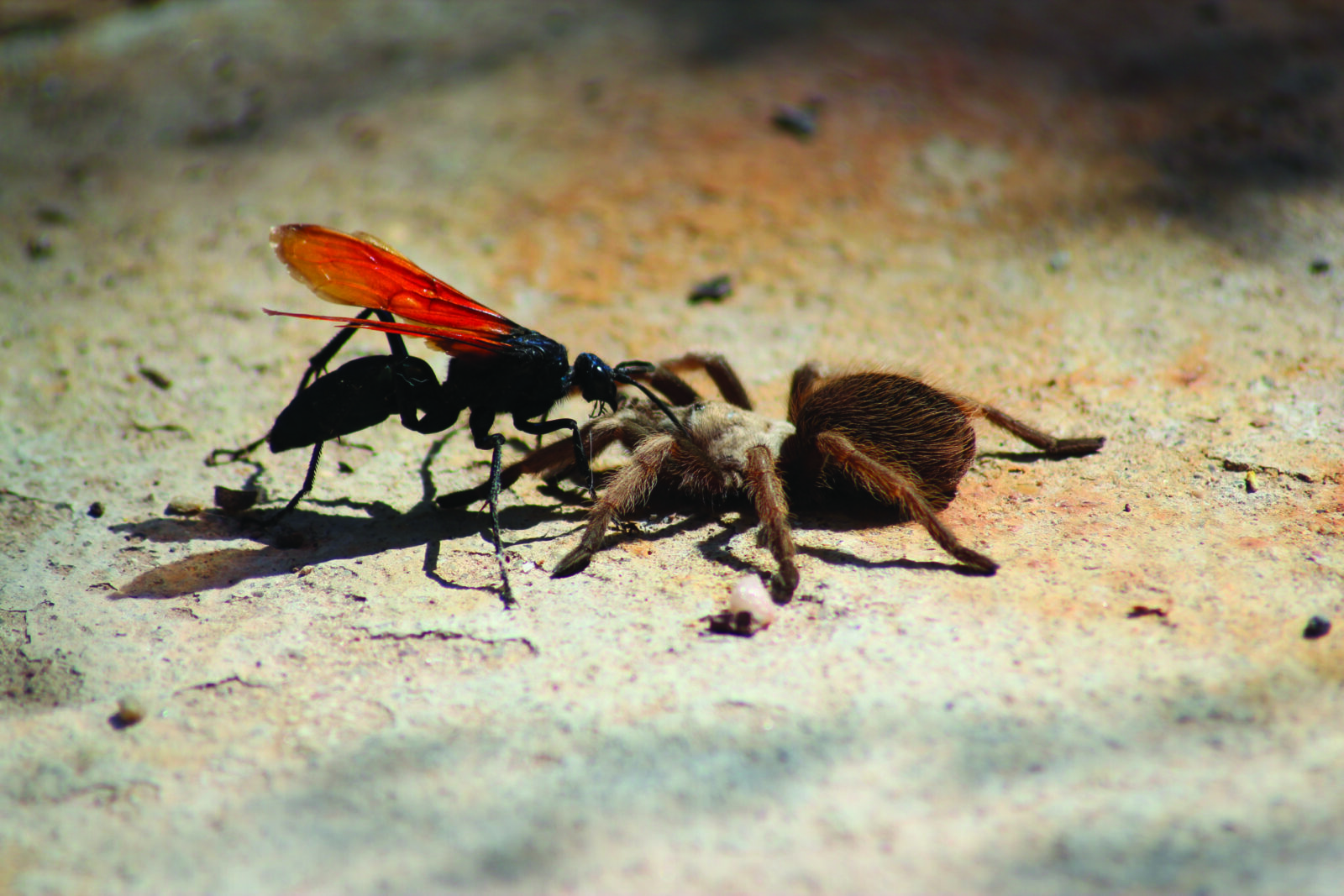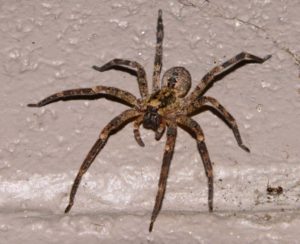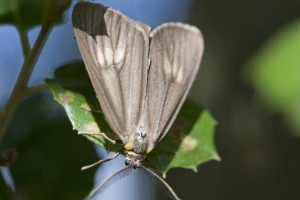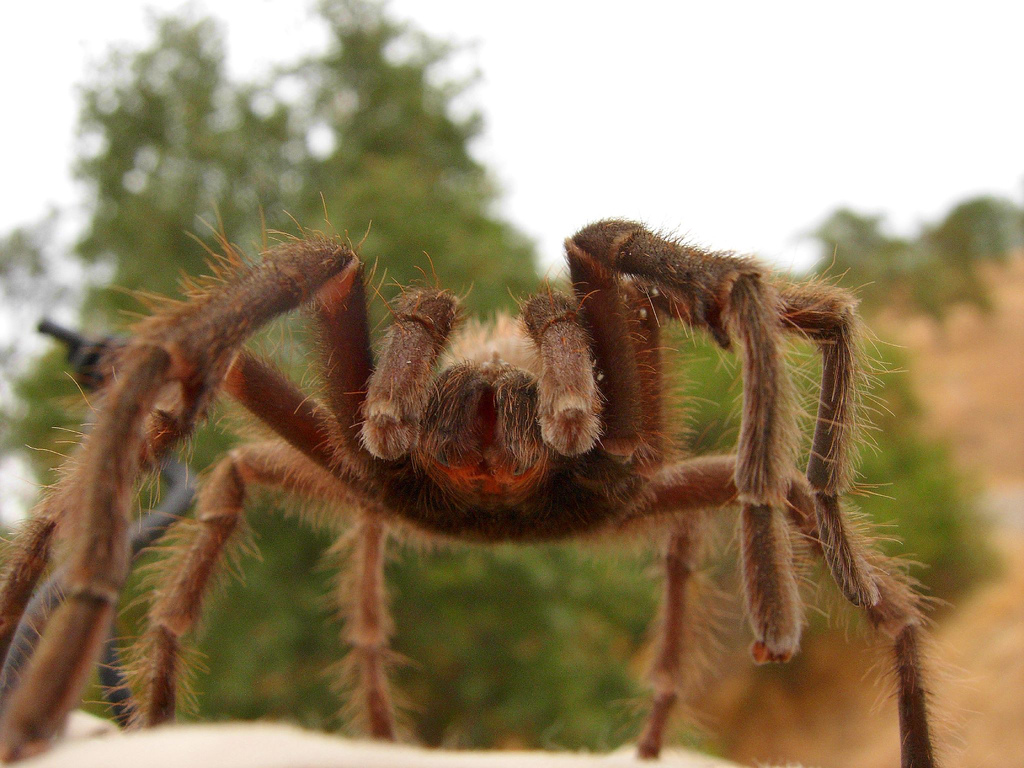
It sounds like a tiny helicopter, motoring through the air. But no—it’s a female tarantula hawk wasp.
Her licorice-black body, two inches long with persimmon-hued wings and velvety, pipe-cleaner-like antennae, glides through the summer skies. Her wings generate a deep, weed-whacker buzz. She is hunting.
Target located, she soars down, sidles up to a tarantula several times her size and strikes.
This battle looks like a thumb war, but it’s deadly. The tarantula tries to protect its vulnerable bits and keep the wasp at bay, raising its abdomen high above its head to avoid getting stung. The wasp darts around the tarantula, dodging fangs and venom. The fight lasts for several minutes. Allan Cabrero, postdoctoral researcher at the National Museum of Natural History, likens it to “a battle of the Titans.” The tarantula is fighting for its life. The wasp is fighting for the survival of her lineage.
Gradually, the tarantula tires. The wasp seizes her moment and sneaks in. She curls her abdomen upward, raises her stinger, and pierces the tarantula, paralyzing it within minutes. (Justin Schmidt, the late entomologist who made it his mission to experience and describe the stings of the insect world, ranked tarantula hawk wasp stings as the world’s second-most painful: “blinding, fierce, shockingly electric. A running hair dryer has just been dropped into your bubble bath.”)
Tarantula subdued, now comes more work. The female wasp drags the tarantula into a burrow she has dug for the task. She embeds an egg inside the tarantula’s abdomen, closes off the burrow’s entrance, then flies away, parental duties fulfilled. She will repeat this process up to 20 times before dying. Each wasp sees a single summer as an adult.
The second act is like something straight out of the movie Alien, according to Zach Brown, an entomology graduate student who helped curate these wasps at the Santa Barbara Museum of Natural History. (This is no coincidence. Alien screenwriter Dan O’Bannon drew inspiration from the insect world for the film.)
Within days, the wasp egg hatches inside the tarantula and develops over the course of a few weeks. Quietly, it munches away on the spider’s innards, at first taking care to avoid any vital organs so that its hairy, eight-legged sleeping bag stays alive. “It’s kind of like refrigerating your meat,” says Cabrero, who has a tattoo of the tarantula hawk over his ribs.
After being paralyzed and eaten alive for weeks, the tarantula dies an empty husk.
Meanwhile, the engorged, grub-like wasp larva is ready for a nap. It pupates, spinning a silk cocoon, says Juanita Rodriguez, Hymenoptera curator and research scientist at the Australian National Insect Collection. There it hunkers down for the winter, right next to the exoskeleton of its former host.
Just as a monarch transforms from wriggly caterpillar to bold, bewinged butterfly, the tarantula hawk wasp metamorphoses from land-bound larva to iridescent, flying imago. When conditions are right and temperatures are warm, the wasp exits its cocoon and begins its adult life—a phase focused on mating, drinking nectar, and, for the females, tracking down tarantulas.
These wasps are thought to keep tarantula populations in check, since they hardly ever lose a fight. And they are known to pollinate some plants. But much of their life history and ecology is still a mystery, even to the scientists who study them.
Mystery or not, when these formidable wasps cross paths with us, they often inspire fear.
“My first impression was, ‘Run away! It’s gonna carry me off—it’s so huge,’’’ says Dee Shea Himes, a local naturalist. But despite being the terrors of the tarantula world, these wasps are fairly docile toward humans—even shy—provided they are unprovoked.
Now, Himes finds joy in sitting and observing these wasps near patches of narrowleaf milkweed. In the Bay Area, you can find a handful out of the dozen or so tarantula hawk species that inhabit the U.S.; a few hundred species exist worldwide.
Listen for these wasps zipping by this summer, off to sip nectar and search for spiders—all in a day’s work for these terrific, tarantula-tusslin’ mamas.
—Lia Keener




